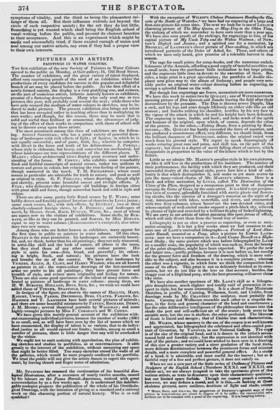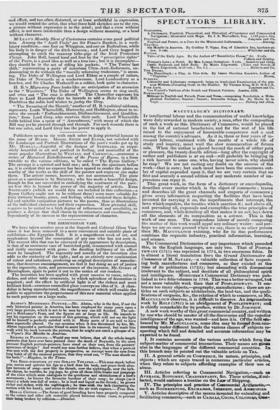Mr. SWADISON has resented the continuation of his beautiful Zoo-
loyical Illustrations, after a secession of nearly twelve months, caused by his labours on the Fauna Boreall-Americana, noticed with great The rage for small prints for scrap-books, and the numerous embeL. lishments of the Annuals, affording a good supply of tasteful novelties on a small scale, leave the purchaser little inclination to buy large prints, and the engravers little time to( devote to the execution of them. Be.. sides, a large print is a great speculation ; the portfolio of double ele- phant now gives way to the album of foolscap; and people very sen- sibly prefer an original water-colour drawing before an engraving, to occupy a splendid frame on the wall. But though line engravings are fewer, mezzotints are more numerous. We have this week to notice two by QUILLEY; one of WITHERINGTON'S amusing picture of Don Quixote and Sancho leaving the field after their discomfiture by the peasants. The Don is thrown across Dapple, blre a sack, and his legs and arms dangle lifelessly on either side like an old armour ; and Sancho rubbing his shoulder, testifies by his wry face to the vigour of the attack in which-be and his knight have been defeated. The engraving is tame, feeble, and hard ; and lacks mach of the spirit and humour of the original, upon which, of course, depends the value of the picture. In the other,—Fishing Boats, from a painting by Box- INGTON —Mr. QUILLEY has hardly exceeded the force of aquatint, and has produced a monotonous effect, very different, we should think, from the brilliant sharpness of BONINGTON, unless the original varied very much from his general style. We regret to speak disparagingly of works evincing great care and pains, and skill too, on the part of the engraver; but there is a degree of merit falling.short of success, which disappoints in proportion to the value of the labour which is lost by the failure. Little as we admire Mr. MARTIN'S peculiar style in his own pictures, we like it still less in the productions of his imitators. The number of their performances, the facility with which they are produced, and their successful rivalry of the original style, prove how low a kind of sub- limity is that which distinguishes it, and make us yet more averse to join the many-voiced chorus of Mr. MARTIN'S 'admirers. Here is a black and white mezzotint, by LUCAS, called The Destruction of the Cities of the Plain, designed as a companion print to that of Sampson carrying the Gates of Gaza, by the same artist. It is a bird's-eye perspec- tive view of scenery, splendidly furnished with exotic plants and flower- ing shrubs, like the interior of a dowager's mansion on the night of a rout, interspersed with lakes, waterfalls, and rivers, and ornamented with two fiery columns, whose bases' are the two devoted cities, and whose capitals of well-curled smoke support a pitch-black sky, relieved by gleams of light and enriched by a brilliant display of forked lightning. We are sorry to see artists of talent pursuing this ignis fatuus of effect, which will only divert them from the broad way of nature. Lithography is not so slow a process as engraving, or even as mez- zotint-scraping. It is but a few weeks since we had occasion to ad- mire one of LANE'S unrivalled lithographs—a Portrait of Lord Alex- ander Russell, mounted on a Pony, after a picture by Enwis LAND.. SEER: now we have a companion to it—Lord Cosmo Russell on a High- land Shelty ; the same picture which was before lithographed by LANZ on a smaller scale, the popularity of which was such as, from the beauty of the print altogether, might have been expected. We prefer the new and larger one,—partly, perhaps, because it is now before us, but mostly for the greater force and freedom of the drawing, which is more suit able to the subject, and also because it is a complete picture ; whereas the other was a vignette, in which form we think the composition lost some of its effect. This print is not so delicately finished as its cony panion, but we do not like it the less on that account ; besides, the shaggy coat of a Highland pony, with the best grooming, wilinever shine like satin. We have also another specimen of Mr. LANE'S skill as a lithogra- phic draughtsman, much slighter and totally void of pretension in re.. spect to style, but far more interesting. It is a sheet of four Miniature Sketches, in profile, of Canning, Wollaston, Scott, and Crabbe, from drawings made by Mr. CHANTREY the sculptor, most probably for busts. Canning and Wollaston resemble each other to a singular de- gree, in the form and general character of the head and countenance ; but the calm deliberative intelligence of the philosopher throws into the shade the pert and self-sufficient air of the orator; both seem to he amiable men, but the one is shallow, the other profound. The likeness of Scott is literal and meagre; that of Crabbe true and characteristie. Mr. WILKIN, whose mastery in the use of the crayon is so well known and appreciated, has lithographed the celebrated and often-copied por- trait of Gevartius, by VANDYKE, in our National Gallery. The cops is of the size of the original head, and it is draWn in the artist's accus- tomed bold and forcible style ; but the expression is not identical with that of the picture ; and we could have wished to have seen in a drawing of this size a greater variety and a nicer gradation of the local.-tints, more delicate discrimination between the prominent forms and minutes details, and a more complete and powerful general effect As a study of a head, it is admirable, and most useful for the learner; but as is faithful copy of a fine and perfect picture, it does not satisfy us. When we see a new part of the little series of Outlinesof Pictures and Sculpture of the English School (Numbers XXXI. and X XXII. are before us), we are always tempted to take the specimens given of the various artists, as texts to discourse upon their characteristic qualities; but our limited space forbids. Though we cannot preach a sermon, however, we may deduce a moral, and it is this,—in looking at these skeleton pictures, mere outlines, destitute of light and shade, colour • MOON, BOYS, and GRAVES, the proprietors of DENNING'S alaeudid ropy of this picture in water-colours, arc about to dispose of it by raffle; the unsuccessful sub. scribers are to be consoled with a proof of the engraving,. Lt.i.i.ataaptinglottery. sand eitedt, and tog often distorted, or at least unfaithful in expression, 'we would remind the artist, that what these bald sketches are to the eye, .a picture without expression is to the mind ; and that a view without effect, is not more intolerable than a design without meaning, or a head without character. M‘LEaw's Monthly Sheet of Caricatures contains some good political hits. Among the " April Fools" are Sir Francis Burdett, in a vacil- latory condition,—one foot on Whiggism, and one on Radicalism, while his body is in danger of the ditch between ; and Lord Grey bogged in attempting to catch the runaway tithe-pigs of the Irish Protestant Clergy. John Bull, hound hand and foot by the "prescriptive rights" of the Peers, is a good idea as well as a true one ; but it is incomplete— they should, be in the act, of rifting his pockets. " The Tories' last shift," representing a party of notorious Ultra-Anti-Reformers, en- deavouring to do without the "rascally reforming tradesmen," is amus- ing. The Duke of Wellington and Lord Eldon as a couple of tailors, the Duke of Newcastle as a washerwoman, Lord Londonderry as a butcher, and Sir Charles Wetherell as a cobler, look quite in character. H. B.'s Migra-tory Peers looks like an anticipation of an accession to the " Waverers." The Duke of Wellington seems to sing small, and cries out " The case is altered," The Chancellor expresses his fears to Lord Harrowby that he intends to add a Rider to the Bill. Doubtless the noble lord wishes to jockey the Grey. " The Swearing of the Horatii," another of H. B.'s political tableaux, -represents Lords Wharncliffe, Harrowby, and Haddington, about to re- ceive the swords " Enfranchisement, Disfranchisement, and Qualifica- tion," from Lord Grey, who receives their oath. Lord Wharncliffe holds behind him a spear of " Amendment," with many of which the Bill may yet be pierced through and through. For such wounds there is but one salve, and Lord Grey has the power to apply it.























 Previous page
Previous page